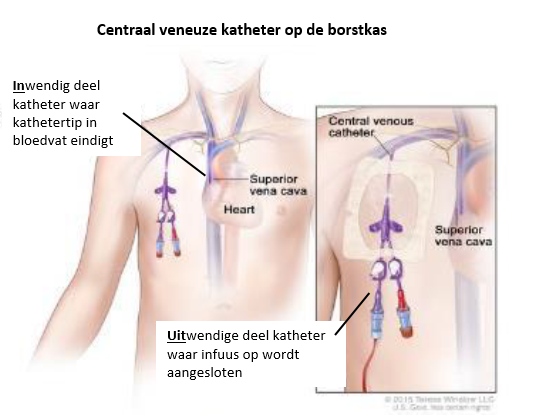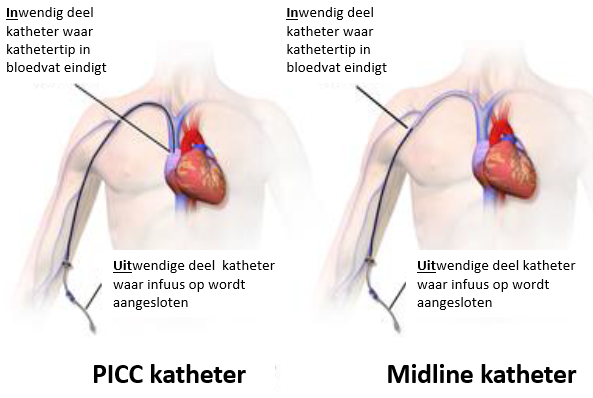You will be treated with intravenous antibiotics outside of the hospital. Intravenous means through a catheter in the veins. Intravenous antibiotics are regularly given in the hospital. For some patients it can also safely be given outside of the hospital. The OPAT-team helps organize this for patients. OPAT is an English abbreviation which means Outpatient Parenteral Antimicrobial Treatment, intravenous antibiotics outside of the hospital. This flyer will give you more information regarding OPAT.
An infection sometimes needs to be treated with intravenous antibiotics. Your doctor will decide the length of the treatment and if it can be safely done at home. Your doctor will consult the OPAT-team on these decisions. Intravenous antibiotics are often started in the hospital, in your situation the treatment can be safely continued outside of the hospital.
Administering intravenous antibiotics
Intravenous antibiotics outside of the hospital are given through a catheter in the veins (CVK). This is a special catheter that gets placed in a big blood vessel. There are different types of CVK, for example a CVK placed on the chest.

A CVK can also be placed in the upper arm, this is either a PICC-line or a Midline. Your doctor will, in consultation with the OPAT-team and regarding the choice for and duration of treatment, decide on which CVK you’ll receive.

Depending on which treatment you need, there can be chosen for administration through a pump with an iv bag/cassette or an easypump. This choice depends on: for how long the antibiotics can be kept, how much fluid the antibiotics need to be dissolved in and whether the dosage of the antibiotics are often changed. Whether the dosage of the antibiotic needs to be changed during the treatment depends on blood levels. Blood will be drawn either once every week or every two weeks.
The following complications can occur after the placement of a CVK:
- blood loss at the insertion site
- pain at the insertion site
- bruising
These complications are normal directly after the CVK placement and are supposed to subside or lessen in two to three days after the placement.
Lifestyle advices for people with a CVK:
Most people notice few CVK complications after placement. They should still follow the following lifestyle advices to prevent certain complications:
- Showering and swimming (max. 15 min) is allowed. However, if the skin under the CVK plaster had gotten wet while showering or swimming it needs to be replaced.
- Visiting the sauna or taking a bubble bath is prohibited.
- Blood pressure should not be measured on the arm the CVK is in. This can cause the catheter to obstruct or get damaged.
- The drawl of blood using the CVK is not preferred. Not only is the personnel at blood drawl points often not qualified to drawl blood using the CVK, it can also cause the catheter to obstruct.
- The drawl of blood from the arm the CVK is in is prohibited.
- It is prohibited to be raised up from under the arms, this can cause the catheter to displace.
When at home/at a healthcare facility:
When at home or in a healthcare facility the nurses will visit daily to administer the treatment and prevent obstruction of the CVK and weekly to care for the insertion site. The transfer-department of the hospital arranges the home/facility healthcare. The OPAT-team will make blood drawl arrangements based on how often monitoring is needed. The OPAT-team prefers for blood drawls to take place in the AMC/VUmc hospital because of logistics. If blood drawl in het hospital is not possible, we’ll gladly help you find a more suitable arrangement.
Benefits of intravenous antibiotics outside of the hospital:
- The antibiotics get administered in a safe, trusted space outside of the hospital.
- There will be more freedom than when the antibiotics are given in the hospital.
- You can continue almost all of your regular day-to-day activities.
Possible side-effects of intravenous antibiotics:
The possible side-effects of intravenous antibiotics, regardless of the location it is given at, are as follows:
- An allergic reaction to the antibiotics, with complaints such as swelling of the lips, tongue, throat, shortness of breath etc.
- Side-effects of the antibiotics, with complaints such as a stomachache, nausea,
- throwing up, diarrhea and rash of the skin with bumps and/or itchiness.
- Possible complications of the CVK include:
- Infection of the insertion site of the CVK
- An occlusion of the catheter of the CVK
- The accidental removal of the CVK catheter
When to contact the OPAT-team:
Luckily complications are rare. However, do not hesitate to contact the OPAT-team if you experience complications of any kind or have any questions. Phone numbers will be displayed at the end of the flyer.
Directly contact the OPAT-team or the AMC/VUmc hospital in the following situations:
- Fever (temperature of 38.5 ºC or higher) or if you are treated with Prednison and have a temperature of 37.5 ºC or higher and/or have cold shivers.
- Pain, swelling or redness of the arm/shoulder/side of the body the CVK is placed.
- Signs of infections at the insertion site of the CVK, with complaints such as fluid or pus, redness, swelling and/or pain at the insertion site.
- Complaints such as swelling of the lips, tongue, throat, shortness of breath, stomachache, nausea, throwing up, diarrhea and rash of the skin with bumps and/or itchiness.
- Complications of the CVK such as damage to/occlusion of the catheter, the accidental removal of the catheter (this will appear as the elongating of the CVK-line, in no circumstance are you to push the catheter back in). In case of the accidental removal/elongating of the catheter, fixate the CVK-line with tape and contact the OPAT-team, AMC/VUmc hospital or home healthcare/facility nurses.
Instruction video’s about the intravenous pump and/or the administering of intravenous antibiotics are found at: www.appo.nl/infuustherapie/prof/instructiematerialen
Phone numbers
In case of emergency (such as complaints of an allergic reaction/side-effects) outside of office-hours contact urgent care/the general practice center near you or the emergency department Amsterdam UMC (Tel: 020 - 566 2222, open 24/7).
In case of non-emergent complaints or questions within office-hours contact the OPAT-team. We are available per telephone or mail from Monday through Friday between 09:00am - 16:00pm.
OPAT-team for patients of location AMC:
- Opat-amc@amsterdamumc.nl
- Tel: 06 – 212 728 73
OPAT-team for patients of location VUmc:
- Vumc@amsterdamumc.nl
- Tel: 06 – 257 164 83
In case of complaints regarding the delivery of the intravenous pumps or antibiotics contact can be sought out with:
- AMC patients:
- APPO Tel: 085 – 902 38 80 (www.appo.nl)
- VUmc patients:
- Mediq Tefa Tel: 030 – 282 12 04 (materials for CADD Solis/Bodyguard pump)
- Amstelland apotheek Tel: 020 - 755 72 68 (antibiotics and material for elastomeres)
Other phone numbers:
- General phone number AMC: 020 – 566 91 11
- General phone number VUmc: 020 – 444 44 44
